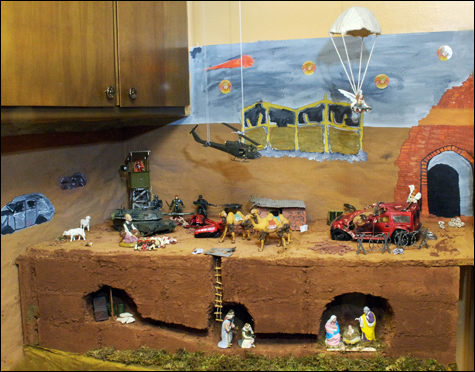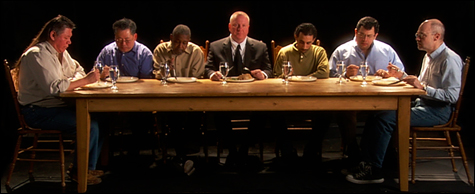Rueful reflectionsTaking stock of the war in Iraq March 12,
2008 1:05:56 PM

NOT A SILENT NIGHT: Baghdad Nativity Scene.
|
|
“Experiencing The War In Iraq” | Machines with Magnets, 400 Main Street, Pawtucket + the Pawtucket Arts Exchange, 172 Exchange Street, Pawtucket | Through March 30
|
March 19 marks the fifth anniversary of the start of our war in Iraq. And with it arrives “Experiencing the War in Iraq,” a timely multi-venue art exhibition and series of video screenings, music, talks, and performances.
The project was sparked last spring when Fall River artist Jeff Carpenter heard from friends about a talk by an Iraq war veteran. An audience member noted that the crowd was mostly gray-hairs and asked the speaker how to attract young people. Carpenter recalls, “He said, ‘Well, they’re probably not going to be so interested in listening to speakers as if you had art and music.’ ”
So that’s just what he set out to assemble with help from co-curators and Providence artists Leif Goldberg, Raphael Lyon, and Erin Rosenthal. An open call attracted about 600 international submissions, from which they chose some 40 pieces to exhibit at Machines with Magnets and the Arts Exchange in Pawtucket. Some of the artists are American veterans or Iraqis. The goal, Carpenter says, is “to reconnect the people who have been disenfranchised or who are cocooning from the reality of the war.”
“We are desensitized to death,” Rosenthal says. “And a lot of these works here bring it back in a way you don’t get from the mainstream media. And that’s why it’s important, because we’re talking about the destruction of human lives.”
An American flag-draped coffin “crashes” through a gallery wall. A monstrous skeletal figure — assembled from bullets, grenades, and artillery shells — haunts one gallery. There are mild-mannered abstractions and generic photos of American troops patrolling Iraq. A video documents a Providence anti-Iraq war street protest. Milton Stevenson creates a mandala of “Support Our Troops” ribbon auto magnets. A couple of artists pulp veterans’ uniforms to turn them into paper.
The art is by turns overwrought and polite; much of it is mixed. But the shows feel scrappy and necessary. They give you space to reflect on the accomplishments and sacrifices of our military: How is the war going? How could it end? Are we safer now? Is Iraq better now? What are the repercussions?
Akela Sciorra-Ortiz, Lucca Sciorra-Ortiz, and Joseph Sciorra’s Baghdad Nativity Scene is a photo of a kitchen diorama of crèche figurines and toy soldiers. The Christian nativity figures — Mary, Joseph, and the baby Jesus and the three wise men bearing gifts — hide from the fighting in underground tunnels. It’s a sweet, sad, ruefully funny child’s play picture of Iraq, touching on the religious overtones of the war and Iraqi families caught in the middle of the violence.
Benton-C Bainbridge and Bobby Previte’s video Sunrise Over Baghdad is a series of flashing pixely images of flags, George Bush, Dick Cheney, Saddam Hussein, Osama bin Laden, and snippets of the ’80s video game Galaga, set to a thumping beat, squeaking synthesized horn, and humming organ. It reflects on how war imagery suffuses our culture.

INEQUALITY: Bilal’s One Chair.
|
Shawn Lawson and Iraq-born, Chicago-based Wafaa Bilal present an interactive video installation, One Chair, which shows a Last Supper tableau of six men seated around a table eating rice and a white guy in the center dining on steak and a potato. When you sit in a chair opposite the projection, the pace of their eating slows, except for the steak guy. Bilal’s work has sparked controversy elsewhere, including the premature closing last week of his exhibition at Rensselaer Polytechnic Institute in Troy, New York, which featured the video game Quest for Saddam hacked so that a suicide bomber instead aims to kill President Bush.
Lauri Richardson’s Iraq War Memorial: Flags of Freedom, Cost of War fills the armory’s old drill hall with 3980 small hand-painted flags, many made by volunteers, representing Americans killed in Iraq. This sort of counting-art has become a familiar tactic. Two other artists use it here: an acetate curtain printed with the faces of American dead and white curtains filled with ribbons counting out how Iraqi deaths far outweigh American fatalities. The aim is to make us feel the scale of the losses, and they do, but the dead remain anonymous abstract numbers.
That’s the nature of much of the work here. In “Experiencing the War in Iraq,” the war mostly remains abstract, distant, generalized, blurry — which is, of course, just how most of us experience it.
|
 |

|
- Reconciling the irreconcilable
- In honor of National Boss Day, thePhoenix.com presents the ultimate kingpins
- Some Things at Trinity
- The wars of evolution are louder than ever. What Ben Stein, Bad Religion, and a physics professor from Quincy can tell you about where you came from.
- Never mind its tough-girl alt-porn feminism: SuicideGirls has already moved on to a new generation
- Israeli magic realism
- How Herald publisher Pat Purcell could pitch inside — and brush back the Globe
- Nancy Goldner on Mr. B
- Swan Lake in Boston and Providence
- The wars of evolution are louder than ever. What Ben Stein, Bad Religion, and a physics professor from Quincy can tell you about where you came from.
- SFD students strut their stuff
- 12 clues that suggest one of Battlestar Galactica's "Final Five" is running for President
|
-
The high voltage work of Corita Kent
-
Walid Raad’s installations seek the “truth”
-
Compelling new work by Neal T. Walsh and William Schaff
-
Malcolm Grear at RIC; plus, Roger Mayer’s ‘Soundless’
-
A local collective subverts with the tiny
-
Shake-ups on the gallery scene
-
The RISD Museum showcases ‘Stryrofoam’
-
Art on the move
-
‘Street Level’ at the ICA, plus Ranjani Shettar and David Claerbout
-
New exhits at the Stairwell, Bannister, and URI galleries
|

- The peculiar American brashness of George Bellows
- Walid Raad’s installations seek the “truth”
- The DeCordova Annual, New Orleans after Katrina, ‘Superartificial,’ 19th-Century Leisure Travel, and El Chango Verde
- ‘Alexis Rockman,’ ‘The New Authentics,’ and ‘Paper Trail II’ at the Rose, and Chantal Akerman at MIT
- Compelling new work by Neal T. Walsh and William Schaff
- ‘El Greco to Velázquez’ at the MFA
- ‘Wedded Bliss’ at the Peabody Essex, Toys and Games at the Revolving Museum, and Chad Walker at Space 242
- The mature art of longtime Maine artists
- Malcolm Grear at RIC; plus, Roger Mayer’s ‘Soundless’
- A local collective subverts with the tiny
|
|